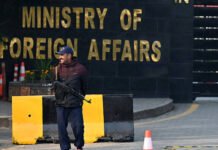Paramaribo, 4 July 2022 (TDI): The 43rd CARICOM Heads of Government Meeting is taking place in Paramaribo, the Republic of Suriname. It started on 3rd July and will end today.
Secretary-General of the UN, António Guterres also attended the 43rd CARICOM Heads of Government meeting. In the meeting, Guterres emphasized the challenges of the Caribbean states, with a special emphasis on the climate crisis.
Guterres first acknowledged the goal of the government of Suriname to preserve 93% of rainforest cover. The Secretary-General remarked that the moment of the Summit was one of maximum peril.
Structural Fragilities
According to Guterres, this was because Covid-19 not only devastated lives, it exposed deep structural fragilities. The first example of those fragilities was that the health systems are underfunded, understaffed, and underequipped.
Another example is the tourism industry, due to Covid restrictions, is struggling to recover from the loss of billions of dollars in revenue.
Then the fact that Russia’s invasion of Ukraine has aggravated these challenges; as importers of 80% of food and net importers of fuel.
The lack of economic opportunities amplifies existing challenges. According to Guterres, the small island and low-lying coastal states of the Caribbean are especially vulnerable to the climate crisis.
Dimensions For Climate Change Actions
Guterres remarked that the Caribbean is ground zero for the global climate emergency. The Secretary-General highlighted three dimensions of climate change to call for bold solutions. The first one is the need to have climate actions that match the scale and urgency of the crisis.
This means that the world needs urgent emissions reduction efforts to maintain warming at 1.5C; to have support for adaptation from climate impacts, and financial assistance to secure a climate-resilient future.
The second dimension is the need to reform the global financial system and spur sustainable recovery across the region. According to Guterres, this is important because developing countries have to be able to access financing, debt relief, and restructuring.
The third dimension is the need to keep up the collective fight against Covid-19. According to Guterres, the world is not out of danger yet; and reaffirmed the need for governments, global and regional organizations; and pharmaceutical companies to work together.
This cooperation is to deliver and create conditions for the local production of tests, vaccines, and treatments.
Final Statement of Guterres
CARICOM
Furthermore, CARICOM encourages and supports a cohesive, resilient, and competitive Caribbean Community that shares in the region’s economic, social, and cultural prosperity.
SIDS
Despite their diversity, small island developing nations (SIDS) are vulnerable to the effects of climate change. The United Nations designated SIDS as a distinct group due to their similarities.
The SIDS calls attention to its problems related to climate change, and advocates for greater ambition against it.
In the report, the authors evaluated patterns of hazards, exposure, and vulnerability. The impacts and risks of certain crises and awareness and knowledge to facilitate a comprehensive understanding of SIDS.
Caribbean SIDS are particularly vulnerable to the effects of climate change because of their size and location. This is because developing economies rely on sectors vulnerable to climate patterns like tourism, agriculture, and fishing.
IPCC ON SIDS
The Intergovernmental Panel on Climate Change, in its fifth assessment report; included a framework to help understand the risk that climate change poses for SIDS.
According to IPCC, the reasons why Caribbean nations’ risk of climate change is high are the continuing rise in sea levels; altered weather patterns; rising temperatures, and intensifying natural disasters.
Despite the distinctions among Caribbean countries, the main threat is climate change. The IPCC estimates that over the past three decades, the region’s average temperatures increased by 0.1° to 0.2°C.
The region’s rainfall patterns changed, and there are predictions that there will be more dry days. Additionally, over the previous 33 years, the sea level has risen at a pace of two to four cm per decade.
A pattern that puts the freshwater supplies of the area and its primarily coastal population, which depends on tourism and agriculture, in jeopardy.
The cost of inaction related to the threat of climate change to the Caribbean is high. According to projections, losses might reach $22 billion yearly by 2050.
That sum is equivalent to nearly 10% of the Caribbean economy as it stands today. Additionally, resources for climate change could assist the area in lowering its reliance on fossil fuels and vulnerability to their price volatility; with benefits for climate change.








